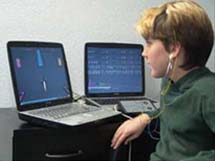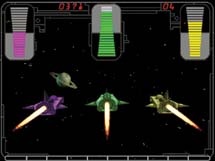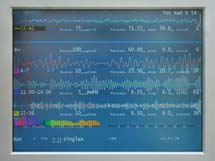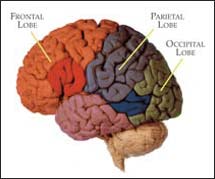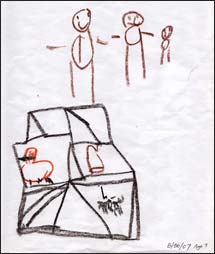"Imagine operating at optimum performance; going to work every day with your mind focused and your body productive; coming home and allowing yourself to relax and enjoy your family; sleeping soundly through the night without distractions. Imagine if it wasn't just a dream."
–Randall Lyle, PhD
(You may read Dr. Lyle's complete article in our Additional Reading section.)
Neurofeedback helps to strengthen, calm and stabilize the brain while improving overall functioning.
Neurofeedback training is a relaxing, non-invasive procedure. Using two computers, one for the client and one for the clinician, we place sensors on the scalp and on the ears. These sensors read the brain activity and feed this information to the computers, while providing auditory and visual feedback for the client. Improvement is usually seen between 10 to 20 sessions (with most needing 35 to 40 sessions total). The impact will be observable, and often quite profound!
Conditions that neurofeedback can help.
- Depression
- Anxiety & panic disorder
- ADD/ADHD
- Learning disability
- Sensory integration
- Insomnia
- Bipolar disorder
- Brain injury
- Obsessive compulsive disorder (OCD)
- Post traumatic stress disorder (PTSD)
It all began with cats: A brief history.
Neurofeedback emerged from work done in the 1960s by psychologist Barry Sterman, a professor at the UCLA School of Medicine (UCLA is still considered one of the leading researchers in the field). He wired electrodes to the heads of cats, then rewarded them whenever their brain waves reached a frequency that indicated a relaxed state. In subsequent experiments in space with NASA, Sterman found, cats that had learned to relax this way had a higher resistance to the onset of seizures. The medical applications seemed obvious: If we could stabilize the brain, we might be able to stave off seizures, anxiety attacks, etc. Neurofeedback was born and the rest is history.
Step one is assessment
Before beginning any treatment, we take a comprehensive assessment of the client’s symptoms (see our Details/Fees/Forms page for more information). Over a period of 30 years, models have been developed that correlate assessment data with brain function. This information will help us decide where to place sensors on the scalp and at what frequency to train your brain.
In neurofeedback, we are not looking for a diagnosis but specific symptoms of underarousal, overarousal and instability. To better understand this, some information about the brain may help.
It's all about the brain.
It is impossible to talk about neurofeedback without talking about the brain. The brain can be looked at in many ways. To simplify, we have divided it into four areas: [illustration of brain, with areas indicated.]
- The Frontal Lobe (just behind the forehead) is in charge. It functions as the executive. If underaroused (sleepy), there may be problems with attention motivation, energy, impulse control, organization, empathy, judgment, ability to learn from mistakes and more. Just beneath the frontal lobe is the amygdala, which is one of the sites we use to treat instability issues of PTSD and OCD.
- The Left Hemisphere if not working optimally, also results in underarousal. Underarousal in this area contributes to depression, daydreaming, ADD (without hyperactivity), low self-esteem, excessive guilt, worry, fatigue, etc.
- The Right Hemisphere when overaroused or wired, may show symptoms of ADHD (e.g., rushing through school work), rage, anxiety, panic attacks, hyperactivity, hyperverbal activity, poor social skills, and even teeth grinding, etc.
- The Parietal/Occipital Lobes (the back part of the brain) contribute to dyslexia, reading skills, eye/hand coordination, sensory integration, balance, eye contact, vision, etc.
From this simplified explanation of brain function you can see how, through assessment, we begin to determine treatment protocols. You can probably begin to guess where we might place sensors to treat a client's symptoms.
Time to get hooked up!
To get "hooked up", we place one or two sensors on the scalp and sensors on one or both ears using paste (It's thick and white and we call it "goo".) The client relaxes and watches the computer screen. A game is played without a mouse, only the brain. When the brain is alert, awake and paying attention, the client hears beeps, which are the "feedback". When the brain processes these beeps (sound waves), it will begin to open neuropathways.
This is training. We are literally training the brain to work optimally. We see clients at least twice weekly for the first 30 sessions or so, then weekly, then monthly until the brain is stabilized and the symptoms are gone.
It's easy! Virtually anyone can do it. It is like watching a video game. Neurofeedback is highly attractive for children, teens or anyone who does not like or has not responded to "talk" therapy.
There's no pain, and it's totally safe.
Neurofeedback training is pain-free and completely safe. Only sound waves and a computer screen are used. There is no electricity required, except to plug in the computer! We have treated many athletes, children, and adults who swear by it, saying they feel more relaxed and more focused.
You may want to read quotes about neurofeedback from professionals and our clients in the Testimonials section.
How long do the effects last?
In general, our clients report that in most instances, results are permanent. Once neuropathways are open and functioning optimally, they tend to continue to stay open. If the client has done enough training (usually 30 or more sessions) and the right type of training, results tend to "stick." Some may experience a relapse of symptoms resulting from a head injury or an extremely stressful illness or life situation. An additional 5-10 sessions can restore balance. Rarely is intensive training needed again. Some clients who have been suffering from long-term fatigue issues (auto-immune diseases, Parkinson's, etc.) may need monthly or quarterly boosters to maintain energy and motivation.
More on the research and benefits of neurofeedback.
Randall Lyle, PhD, summarized benefits and research in an article he published in the San Antonio Business Journal:
"The benefits of neurofeedback are overwhelming. According to EEG Spectrum International, follow-up studies on children with ADD who received neurofeedback training showed significant increases in academic and behavior scores. Some children even jumped as much as two years in grade level achievement and boosted their IQ by about 15 points.
Studies are also being done on neurofeedback and addiction. After a month long neurofeedback treatment, alcohol addicted clients achieved an 80 percent abstinence rate. A follow-up review showed that 70 percent remained abstinent.
Neurofeedback has been proven so effective in treating Traumatic Brain Injury (TBI) that the Texas Legislature passed a law preventing insurance companies from denying coverage for it if the client is being treated for TBI. Another effort is currently under way to lobby the State to mandate the same coverage for those being treated with autism spectrum disorders."
As more research is conducted and positive results documented, neurofeedback can only grow in acceptance and help thousands with its unique way of encouraging the brain to function in a more stable and holistic way.
You may be interested in reading Dr. Lyle's complete article, Crossroads Counseling's 7-page neurofeedback handout, as well as more research, links, articles and books on neurofeedback, all found in our More Reading section.

